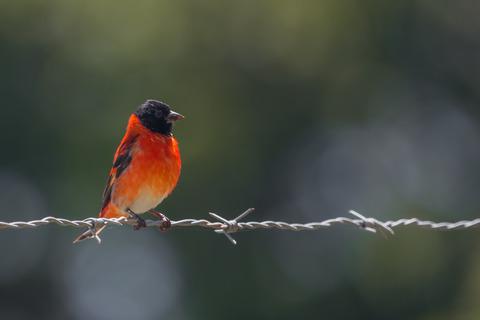当前位置:
X-MOL 学术
›
Anim. Conserv.
›
论文详情
Our official English website, www.x-mol.net, welcomes your feedback! (Note: you will need to create a separate account there.)
Social network analysis reveals specialized trade in an Endangered songbird
Animal Conservation ( IF 3.4 ) Pub Date : 2019-08-13 , DOI: 10.1111/acv.12514 A. Sánchez‐Mercado 1, 2 , A. Cardozo‐Urdaneta 2 , L. Moran 1 , L. Ovalle 3 , M. Á. Arvelo 2 , J. Morales‐Campos 2 , B. Coyle 4 , M. J. Braun 5, 6 , K. M. Rodríguez‐Clark 2, 7, 8
Animal Conservation ( IF 3.4 ) Pub Date : 2019-08-13 , DOI: 10.1111/acv.12514 A. Sánchez‐Mercado 1, 2 , A. Cardozo‐Urdaneta 2 , L. Moran 1 , L. Ovalle 3 , M. Á. Arvelo 2 , J. Morales‐Campos 2 , B. Coyle 4 , M. J. Braun 5, 6 , K. M. Rodríguez‐Clark 2, 7, 8
Affiliation

|
Unsustainable harvest is one of the most important threats to biodiversity, and birds are highly impacted, but avian markets remain poorly understood. When species value and corruption/criminality are high, the “parallel trafficking” hypothesis predicts that illegal animal items will move through networks used for other illicit products. Alternatively, when particular demands, logistical skills or access limits trade, “specialized trafficking” hypotheses predict that few, expert actors will control markets. Here, we use social network analysis of trade in an Endangered songbird, the Red Siskin Spinus cucullatus, originating in Venezuela, to examine the generality of the parallel trafficking hypothesis in a setting where corruption/criminality and species value are high. In spite of these circumstances, of 2575 Red Siskin (RS) records compiled from 2010 to 2017, we found just six reports consistent with parallel trafficking. Instead, we discovered an independent network of 15 actor types, and a trade structure consistent with specialized trafficking. Just two intermediary types (national vendors to intermediaries and to consumers) and one consumer type (national breeders) had the highest exposure to the flow of birds, and the most trade connectivity. Use of wild‐caught over captive‐bred birds was high (67% of records), as was use of natural‐phenotype birds over hybrid or mutant‐phenotype birds (65% of records). Geographically, Spain and Venezuela had the highest exposure to the flow of birds, but Brazil and Colombia had the most direct connections with other countries. The unexpected lack of evidence for parallel trafficking suggests that combined flows of illicit products are not inevitable, even in adverse settings. In a context where law enforcement may not be feasible, our results suggest that it may be possible to reduce unsustainable harvest using breeder connectivity in informational campaigns to stimulate peer‐to‐peer interactions and accelerate behavior change.
中文翻译:

社交网络分析揭示了濒危鸣禽的专业贸易
不可持续的收获是对生物多样性最重要的威胁之一,鸟类受到严重影响,但鸟类市场仍然知之甚少。当物种价值和腐败/犯罪率很高时,“平行贩运”假设预测非法动物物品将通过用于其他非法产品的网络移动。或者,当特定需求、物流技能或准入限制贸易时,“专门贩运”假设预测很少有专家参与者会控制市场。在这里,我们对原产于委内瑞拉的濒危鸣禽 Red Siskin Spinus cucullatus 的贸易进行社交网络分析,以检查在腐败/犯罪和物种价值很高的环境中平行贩运假说的普遍性。尽管有这些情况,在 2010 年至 2017 年编制的 2575 份 Red Siskin (RS) 记录中,我们发现只有 6 份报告与平行贩运一致。相反,我们发现了一个由 15 种行为者类型组成的独立网络,以及一个与专门贩运相一致的贸易结构。只有两种中介类型(国家供应商到中间商和消费者)和一种消费者类型(国家饲养员)对鸟类流动的影响最大,贸易联系最多。野生捕获的鸟类比圈养繁殖的鸟类的使用率很高(67% 的记录),自然表型鸟类的使用率高于杂交或突变表型鸟类(65% 的记录)。从地理上看,西班牙和委内瑞拉与鸟类流动的接触率最高,但巴西和哥伦比亚与其他国家的联系最直接。平行贩运的意外缺乏证据表明,即使在不利的环境中,非法产品的联合流动也并非不可避免。在执法可能不可行的情况下,我们的结果表明,在信息活动中使用育种者连接来刺激点对点互动并加速行为改变,可能会减少不可持续的收获。
更新日期:2019-08-13
中文翻译:

社交网络分析揭示了濒危鸣禽的专业贸易
不可持续的收获是对生物多样性最重要的威胁之一,鸟类受到严重影响,但鸟类市场仍然知之甚少。当物种价值和腐败/犯罪率很高时,“平行贩运”假设预测非法动物物品将通过用于其他非法产品的网络移动。或者,当特定需求、物流技能或准入限制贸易时,“专门贩运”假设预测很少有专家参与者会控制市场。在这里,我们对原产于委内瑞拉的濒危鸣禽 Red Siskin Spinus cucullatus 的贸易进行社交网络分析,以检查在腐败/犯罪和物种价值很高的环境中平行贩运假说的普遍性。尽管有这些情况,在 2010 年至 2017 年编制的 2575 份 Red Siskin (RS) 记录中,我们发现只有 6 份报告与平行贩运一致。相反,我们发现了一个由 15 种行为者类型组成的独立网络,以及一个与专门贩运相一致的贸易结构。只有两种中介类型(国家供应商到中间商和消费者)和一种消费者类型(国家饲养员)对鸟类流动的影响最大,贸易联系最多。野生捕获的鸟类比圈养繁殖的鸟类的使用率很高(67% 的记录),自然表型鸟类的使用率高于杂交或突变表型鸟类(65% 的记录)。从地理上看,西班牙和委内瑞拉与鸟类流动的接触率最高,但巴西和哥伦比亚与其他国家的联系最直接。平行贩运的意外缺乏证据表明,即使在不利的环境中,非法产品的联合流动也并非不可避免。在执法可能不可行的情况下,我们的结果表明,在信息活动中使用育种者连接来刺激点对点互动并加速行为改变,可能会减少不可持续的收获。



























 京公网安备 11010802027423号
京公网安备 11010802027423号